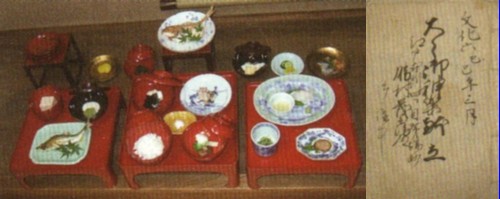Onshi Maruoka Sodayu Residence

Onshi Maruoka Sodayu
Maruoka Sodayu was once an onshi in theYamada area (today's lse City).
He moved to the present site at Eboshizeko,a narrow street in Shimona-kanogo
town in 1602. Until the Meijigovernment ordered an end to the onshi business in
July 1872,his family worked as onshi,a kind of Shinto priest of Ise Jingu (Geku),
and also as administrative officers in theself-governed Yamada area.
Maruoka Sodayu was a mid-level onshi whorepresented 8,000 households in
Osaka and Nagano Prefecture. Some notebookswere found in the Maruoka
Sodayu house that contained information onwhat fees were collected,the visitors'
schedules as well as menus. Wecan also see memorial prayer plaques, vermilion
lacquered dinnerware,and other historical artides in the house.
*Onshi were people who served as innkeepers,tour guides,and priests to people
visiting Ise Jingu from other areas.

A recreation of a dinner menu found in an oldbook from the Maruoka Sodayu house
served on antique dinner ware.
A menu used for guests from Fukagawa Edo (today's Tokyo).
The only remaining onshi house
This house is the only remaining residence ofan onshi and therefore is an important
part of Japan's history. Theremnants show that the Maruoka family lived there for many generationsbeginning in the 17th century.
According to documents found in the house,the Nagayamon* gate,main
entrance,kitchen,and mainresidence were built in 1866 at a cost of 700 gold ryo.
It survived the air bombing inJuly 1945. Ultimately,the south part of the house was
lost to decay,however,the 230 square meter main building is still intact.
Currently,there are some old gates of onshi houses in Ise City. The Fukushima
Misakidayu gate is at theentrance of the Jingubunko library and the Hayamadayu
gate is near the easternpart of Chokokan museun.
However, they are Yakuimon*type gates, notthe Nagayamon type like that found at
the Maruoka Sodayu house.
After the end of the onshi business in 1872,many documents and artifacts related
to onshi were lost from the Yamada area.So, the Maruoka Sodayu house is very
important resource for us tostudy the history of the Yamada area, because it has its
ownbuilding, documents and antiques still intact.
*Nagayamon gate:
A gate with a warehouse. Rooms were builton either side of the gate and they were
often used as guardhouses. Theywere often found in Bukeya-shiki (samurai
residences) in the Edoperiod.
*Yakuimon gate:
A gate having one roof covering both mainand rear pillars.

amulet printing block

Onshi in Ise Yamada
The onshi's job was to convey people'sprayers to the deities of Ise Jingu. The inner
sanctum of IseJingu was exclusive to the Emperor until the Meiji period.
In Japanese,this is called Shihei Kindan. It was built for theemperor to pray for
peace and good harvests. However,towards the end of the Heian period,as the
legal system (called Ritsuryo) became unstable,Ise Jingu faced an economic crisis
and many Jingu territories were taken over by samurai warriors. On the other
hand,court nobles,(called Kuge) and feudal lords (called Daimyo) still wantedto
worship at Ise Jingu. Onshi started giving Kagura* prayersat their own premises for
powerful people other than the emperor. This was the start of the onshi profession.
In the Edo period,onshi started visiting ordinary people and farmers all over Japan
to sell talismansfrom Ise Jingu and to receive fees for performing ceremonies. Onshi
provided lodging,food and drink,local tours,and Kagura prayers. ln the mid-18th
century,there were 750 onshi (480 in Yamada and 270 in Uji) in today's Ise City
and they welcomed pilgrims from all over Japan.
The onshi not only acted as Shinto priestsbut also as administrative officers of the
Yamadaself-governed area.
As for the economy,onshi built trust in the economy by distributing Yamada
notes,the oldest paper money in Japan,which were first issued in the Yamada
area. In addition,they established Toyomiyazaki Bunko library and school. There
they collected many valuable books to offer education and invited some prominent
scholars to visit.
*Kagura a ceremony involving the reading of prayers,dancing and purfication with
boiled water and a ritual object called a sakaki.

Onshi in Ise Sangu Meisho Zue:

A geographical booktet of historic sites inIse Yamada (today's Ise City) in the latter
part of the Edo period.
Restoration of the Maruoka Sodayu house
In December,2010,volunteers whowere concerned about the house got together
to clean and openthis historical building to the public. 0n Apri1 18,2012,NPO Kyu
onshi Maruoka Sodayu Tei Hozon Saisei Kaigi (NPO Onshi Maruoka Sodayu
House Restoration Committee)was established. Monthly cleaning,repairing,and
gardening are the main activities of the committee.
NPO activities
Some of the NPO Onshi Maruoka Sodayu House Restoration
Committee activities indude ancient document seminars,recreation of onshi menus,
talisman making
classes,pilgrim-themed tours and walking tours around the Yamada area and
educational programs for elementary school students and foreign exchange students.
Cooperation
Building inspection and drawings fordocumenting the house are done by the Ise
architects association. Ancient document organization and bibliography making
aredone by the Ise City History Compilation section. Antique investigation is
performed by the Mie Prefectural Museum.
Ancient document seminars are offered by students from Kogakkan university.
Public viewing and event management are handled by the Ise local History Association.
Regisiered tangible cultural assets of Japan
As a result of these restoration activities,the main building, Nagayamon gate,and Tsuijibei fence became registered tangible cultural assets of Japan on August4,2015.
It is now known to the public that the house is a highly important part of our
historical heritage,and the committee hopes that visitors approve their restoration
activities and the house becomes a center for Ise Yamada history and culture through the aforementioned activities they offer.
Non-profit Organization
Kyu Onshi Maruoka Sodayu Tei Hozon SaiseiKaigi
address:1-9-7 Miyamachi, Ise City
TeL: 0596-27-0455
E-mail: tak17@amigo2.ne・jp
Photograohy by Kazyhuri Suzuki (2015)
Translation by Yuko Hanabusa.
Copyright © Kyu Onshi Maruoka Sodayu Tei Hozon SaiseiKaigi
